03.07.2017, Kuching: Be it exploring something new or to re-learn our history, the documentaries brought by National Geographic have drawn Lukmann Haqeem to be part of the conservation world.
Working as senior field biologist in WWF-Malaysia under the Sarawak Conservation Programme, Lukmann reminisced, “The show instils the desire to explore nature in me. I have always liked the idea of becoming a pioneer and taking human civilisation to a new level.”
When he was in secondary school, he developed an interest in Biology. During his final year of high school, he won the overall best student for the subject. This propelled Lukmann to pursue his studies in Ecology and Biodiversity at the University of Malaya, Kuala Lumpur.
“I figured that I will do something that I’m good at and passionate about at the same time. Becoming a field biologist is like a dream come true as it incorporates both exploring nature and my love for biology,” said the 29-year old conservationist.
Lukmann, who is fondly known as Bob, now spends most of his time researching wild animals, especially orangutans. He began developing an interest in working with orangutans after watching several documentaries on the charismatic species.
“Although orangutans are popular animals, not much is known about them. I decided to study them because I wanted to find out the answers myself.”
He also mentioned that the orangutan has the slowest breeding rate of any primate and is one of the most slow-breeding mammals. The interval between one birth to the next can be as little as three years or as long as eight years.
“That is why it is important to conserve them. There is no certainty on when the next generation will be born. The death of an orangutan is always a big loss to their community,” he adds.
He usually spends about two and a half months to complete a survey on orangutan nests. Within that period, he will conduct three sets of field surveys, about two to three weeks for each survey with short breaks in between.
Like any other field biologist, Bob also faces many challenges. In Sarawak, the orangutan lives in rugged terrains and so Bob has to hike up and down several mountains before reaching any orangutan habitat. Besides that, he also needs to carry his own supplies into the jungle which can weigh more than 20kg.
“Another challenge will be with the orangutans themselves. They are elusive and very hard to detect. Orangutans are known to hide themselves among the canopy when they sense potential danger. Sometimes it takes me weeks before actually seeing one.”
Currently, Bob is assisting in a new transboundary green economy project area in the Heart of Borneo (HoB), funded under the International Climate Initiative (IKI), Federal Ministry for the Environment Nature Conservation, Building and Nuclear Safety of Germany.
This two-million hectare site stretches from central Sarawak, Malaysia to northern West Kalimantan, Indonesia. The project site in Sarawak includes two important orangutan areas which are also biologically rich – Batang Ai National Park and Lanjak-Entimau Wildlife Sanctuary.
One of Bob’s tasks is to investigate species presence within the HoB landscape, and to advocate for the conservation of areas where they are found so that they can have the opportunity to thrive.
“Both sites are where most orangutans in Sarawak live. Although they live in protected areas, they don’t know what a boundary is. There are always possibilities that they will travel outside the protected areas and into the hands of hunters and poachers,” he explains.
Currently there are about 1,600 orangutans left in Sarawak. This figure is nothing compared to 11,000 orangutans found in neighbouring state of Sabah.
Bob hopes that his efforts, along with that of other experts and stakeholders, will help the orangutan population in Sarawak continue to thrive for posterity.
In Sarawak, some communities, like the Ibans, have a cultural connection with orangutans. The orangutan is revered by them as they believe that humans either are descended from the orangutan, or they turned into orangutans when they die. It is also a taboo to kill orangutans according to the Iban native law.
“The people in Batang Ai still practise this cultural connection and hence orangutans are able to survive there. However, this connection has diminished in other places and orangutans have been wiped out as a result of habitat destruction and illegal killing.”
“I hope our conservation efforts will help people to re-establish their culture and connection with orangutans. With the taboo in place, orangutan populations will hopefully recover naturally and they can live harmoniously with these communities,” he said.
The orangutan is Asia’s only great ape and is found only on the islands of Borneo and Sumatra. In Malaysia, the orangutan sub-species, Pongo pygmaeus pygmaeus, occurs in Sarawak and West Kalimantan; and Pongo pygmaeus morio occurs in Sabah and East Kalimantan. In Sarawak, most orangutans occur mainly in protected areas, but incidental poaching cannot be totally ruled out due to lack of management presence in many of the orangutans’ habitats and protected areas. The orangutan is classified as Totally Protected under the Sarawak Wild Life Protection Ordinance (1998).
– Ends –
About WWF-Malaysia
WWF-Malaysia (World Wide Fund for Nature-Malaysia) was established in Malaysia in 1972. It currently runs more than 90 projects covering a diverse range of environmental conservation and protection work, from saving endangered species such as tigers and turtles, to protecting our highland forests, rivers and seas. The national conservation organization also undertakes environmental education and advocacy work to achieve its conservation goals. Its mission is to stop the degradation of the earth’s natural environment and to build a future in which humans live in harmony with nature, by conserving the nation’s biological diversity, ensuring that the use of renewable natural resources is sustainable, and promoting the reduction of pollution and wasteful consumption. For latest news and media resources, visit http://www.wwf.org.my/media_and_information/media_centre/
About HoB IKI Green Economy Project
The Heart of Borneo (HoB) corridor is a 22-million hectare landscape of forests that are home to a diverse group of wildlife species such as Orang Utan, Clouded Leopard, Pygmy Elephant and Sumatran Rhino. The corridor aims to create an ecological link between protected areas in Brunei Darussalam, Malaysia and Indonesia. The HoB corridor is one of WWF’s global priority conservation areas, and an important socio-economic development area for local and indigenous people.
The Green Economy in the HoB project will be developed within a two-million hectare site, spanning from Northwest Kalimantan to central Sarawak. The project is funded under the International Climate Initiative, by the German Federal Ministry for the Environment, Nature Conservation, Building and Nuclear Safety.
The project aims to pilot the development of a green economy land use and management plan, which promotes environmentally-friendly economic growth within the HoB Corridor.
Note to the media:
- All quotes are to be attributed to the designated persons quoted in this media release.
- Should you need more information, please contact:
Amanda Nayra Michael Jengging
Tel: +6082 247420 Ext. 227
Email: ajengging@wwf.org.my
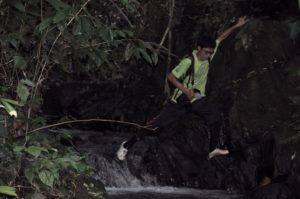
One of many challenges – crossing streams to get to the field site. Photo credit: © Jenny Ngeian Machau
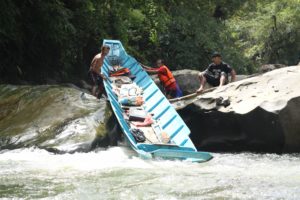
Sometimes the only of mode transportation to the field site is by using a long boat. During dry season, Bob and his field team have to push the boat across boulders. Photo credit: © Lukmann Haqeem
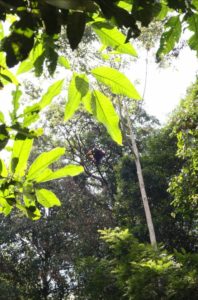
Orangutan usually live up around the canopy area and is very agile in travelling across canopy. Photo credit: © Lukmann Haqeem
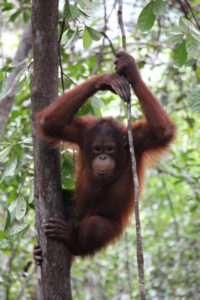
A young orangutan. The orangutan landscape in Sarawak is an important area for the Green Economy Project. Photo credit: © WWF-Malaysia/Zora Chan
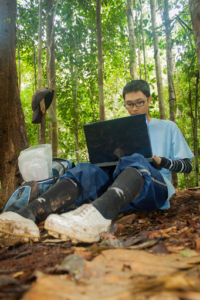
In the field, Bob multitasks a lot. While sorting out data, Bob timed his camera to take his own picture. Photo credit: © Lukmann Haqeem


